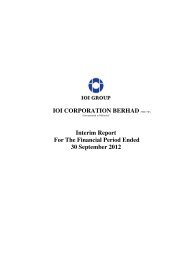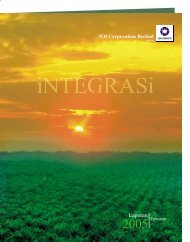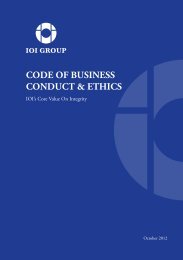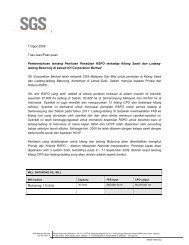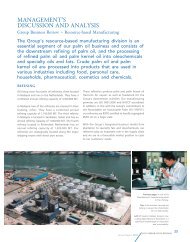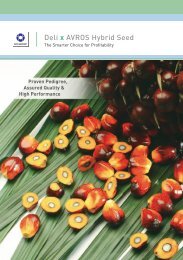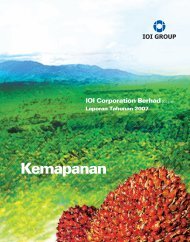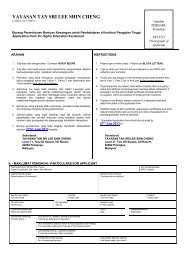Annual Report 2012 - IOI Group
Annual Report 2012 - IOI Group
Annual Report 2012 - IOI Group
Create successful ePaper yourself
Turn your PDF publications into a flip-book with our unique Google optimized e-Paper software.
5. SIGNIFICANT ACCOUNTING POLICIES (Continued)5.14 Financial Instruments (Continued)Financial instruments are classified as assets, liabilities or equity in accordance with the substance of the contractualarrangement. At initial recognition, a financial instrument is recognised at fair value plus, in the case of a financial instrumentnot at fair value through profit or loss, transaction costs that are directly attributable to the acquisition or issuance of thefinancial instrument. Interest, dividends and losses and gains relating to a financial instrument or a component that is afinancial liability shall be recognised as income or expense in profit or loss. Distributions to holders of an equity instrumentare debited directly to equity, net of any related tax effect. Financial instruments are offset when the <strong>Group</strong> has a legallyenforceable right to offset and intends to settle on a net basis or to realise the asset and settle the liability simultaneously.An embedded derivative is separated from the host contract and accounted for as a derivative if, and only if the economiccharacteristics and risks of the embedded derivative is not closely related to the economic characteristics and risks of thehost contract, a separate instrument with the same terms as the embedded derivative meets the definition of a derivative,and the hybrid instrument is not measured at fair value through profit or loss.5.14.1 Financial assetsA financial asset is classified into the following four categories after initial recognition for the purpose of subsequentmeasurement:i. Financial assets at fair value through profit or lossFinancial assets at fair value through profit or loss comprise financial assets that are held for trading (i.e.financial assets acquired principally for the purpose of resale in the near term), derivatives (both, freestandingand embedded) and financial assets that were specifically designated into this classification upon initialrecognition.Subsequent to initial recognition, financial assets classified as at fair value through profit or loss are measuredat fair value. Any gains or losses arising from changes in the fair value of financial assets classified as at fair valuethrough profit or loss are recognised in profit or loss. Net gains or losses on financial assets classified as at fairvalue through profit or loss exclude foreign exchange gains and losses, interest and dividend income. Suchincome is recognised separately in profit or loss as components of other income or other operating losses.However, derivatives that are linked to and must be settled by delivery of unquoted equity instruments thatdo not have a quoted market price in an active market are recognised at cost.Financial assets classified as financial assets at fair value through profit or loss include short term investmentand short term funds.ii.Held-to-maturity investmentsFinancial assets classified as held-to-maturity comprise non-derivative financial assets with fixed or determinablepayments and fixed maturity that the <strong>Group</strong> has the positive intention and ability to hold to maturity.Subsequent to initial recognition, financial assets classified as held-to-maturity are measured at amortised costusing the effective interest method. Gains or losses on financial assets classified as held-to-maturity arerecognised in profit or loss when the financial assets are derecognised or impaired, and through theamortisation process.<strong>Annual</strong> <strong>Report</strong> <strong>2012</strong><strong>IOI</strong> CORPORATION BERHAD 143



